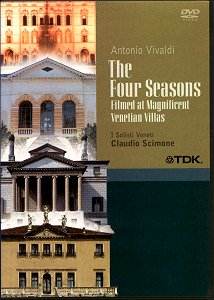Comparison DVD recordings:
Vivaldi: L’Estro Armonico, Op
3. Capella Istropolitana. Naxos DVDI
1030
Vivaldi: Le Quattro Stagione,
Julia Fischer, ASMF BBC-OpusArte DVD
OA0818D
If I were to play for
you the Stokowski CD version of this
work and this Solisti Veneti recording
without showing you the labels and then
asked you to guess which was which,
you’d probably get them reversed. Stokowski
gave us a pretty straightforward reading.
Scimone shapes the phrases with deep
rubato and ritards, long pregnant fermatas,
just as one would expect Stokowski to
do, and with all the good and bad effect
that one would expect. Rhythmic tension
is often sacrificed. At times one is
enchanted by Scimone’s touching-up,
at other times annoyed and distracted
by it. Harpsichord, lute, and
organ appear as continuo instruments,
sometimes all at once.
Degani plays the gorgeous
slow movement of Winter very
nicely and affectingly, straight through
with no funny stuff. As Scimone points
out, the slow movements of Vivaldi’s
concerti derive from the solo arias
from his operas. And, also, from eyewitness
reports, Vivaldi himself improvised
his breathtakingly virtuosic solo cadenza
after (not during) the melody, just
before the final recapitulation. Why,
then does he have Chiarra Parrini over-embellish
the slow movement of Summer?
(Scimone explains this in his talk.)
Visually we switch
back and forth between watching the
musicians, seated in a large chamber
in a Venetian villa, and moving through
the interiors, exteriors and gardens
of five Italian villas. In fact the
camera is hardly ever still, moving
through and around the orchestra, down
hallways, back and forth and up and
down on frescos There must have been
some wild parties in these rooms with
the walls covered with these larger
than life realistic images of naked
nymphs and satyrs, all disporting enthusiastically.
Who needed adult videos? Only during
some of the flower close-ups in the
gardens is the camera still. During
the intervals between concerti we have
garden sounds — birds and insects.
The extras include
Temples of the Sun and the Moon,
an RAI TV special tour of Venetian villas,
with moving camera as described above,
accompanied by pop ballades, e.g., "All
the Things You Are", "Autumn
Leaves", "Someone to Watch
Over Me", "Just the Way You
Look Tonight", "Smoke Gets
In Your Eyes", also a commercialized
arrangement of a Mozart rondo, played,
some in swing time, on the solo harp
by Michela la Fauci. Quotations from
poets are shown in Italian on the screen
and translated in subtitles. The subject
architecture and artwork are stunningly
beautiful and the moving camera is slow
enough so that you can, by using the
slow and pause button on your remote,
actually see something — except when
they get too arty with slow fade montages,
sometimes three deep, of scenes moving
in different directions. And, of course
you can just turn off the music — if
you find it as silly as I do — and play
something else.
Scimoni’s half hour
talk is full of interesting information
about the history of the form and the
works at hand, in fluent Italian with
subtitles. Scimone’s Venetian accent
is so thick my room mate could hear
it through a closed door. After an introduction
seated at the harpsichord, he joins
his musicians who play examples of tone
painting as he describes them, including
a chorus singing the original operatic
version of the opening theme of Primavera.
If you want a great
video performance of the Four Seasons,
buy the Julia Fischer DVD. The performance
is traditionally authentic and beautifully
played by all concerned. Recorded sound
is superlative. The video nature sequences
in the Welsh National Arboretum are
very attractive, but if you want you
can turn them off and watch the musicians
only instead. If you’re a special fan
of Scimone’s and want to hear his lecture,
or if you’ve already had your fill of
the Four Seasons and want something
exotic, out of the ordinary, buy this
Scimone performance. Chiarra Parrini
is older and not so attractive as Julia
Fischer, but she plays almost as well,
and wears black instead of technicolor
glitter.
If you can’t get enough
of Venice and Venetian art and architecture,
buy this Scimone video, and also the
Naxos Estro Armonico which includes
a tour of Venice in the wintertime.
I’ll never go there, and these video
tours, despite their shortcomings, are
wonders to behold. You get from them
much more of a sense of place than you
do from coffee table books.
Paul Shoemaker







